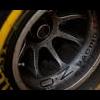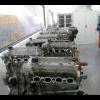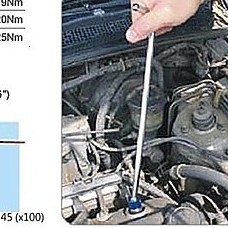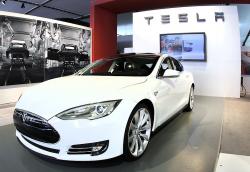Search the Community
Showing results for tags 'electric'.
-

Kid gets electric miniature C7 Stingray which can do burnouts
chitchatboy posted a blog entry in MyAutoBlog
This four-year old kid is one lucky guy. This miniature C7 Chevorlet Stingray, which can do burnouts and donuts, belongs to him. Thanks to his cool dad, his little toy has double the voltage (from the factory's 12 volt to 24 volt) and a upgraded drivetrain that uses steel gears rather than the stock plastic ones to handle the additional poke. We are sure he would grow up to be a proper petrolhead. https://www.youtube.com/watch?v=dIkmCb70-3M-
- kid burnout
- c7 stingray
-
(and 2 more)
Tagged with:
-
There arent many Evs in singapore as theres not really an after sales infrastrature in place to support owning one and the lack of battery tech means that range is limited before a charge is needed. Furthermore as most of us live in hdb aparements, current recharging stations are not really widespread yet because they are mostly bulky,cumbersome and are located out of the way. This negativity causes many to overlook it as an alternative to petrol powered vehicles. Could there be a retractable reel like charging wire ( just the charging adapter from the shown charging point above)that comes down from above and retracts back into the ceiling once the charging is finished, like a wall socket ? This could enable many lots to be used as an ev charging point, especially if ev cars take off, or it may even spur ev ownership. Imagine charging your car at home without the need to fuel up at a petrol station. Or as an alternative,an EV charging station, which like a petrol station with the idea above. With the compact nature of the charging lot, it can even possibly be a multi level charging station, serving quite a number of cars, possibly more than what a petrol powered variant could do without the relative dangers of fuel vapours etc. Something like this Station staff collects the car, drives inside and parks the car in one of the ev station lots, and returns the car once the charging is done. Payment while waiting.
-

Ferrari Considers Supercharged Engine With Electric Turbocharger
Deeq posted a blog entry in MyAutoBlog
If you thought the new era of F1 with small, hybrid, turbocharged cars was a bad idea, listen up. Not only have Mercedes and Audi revealed new engines and cars that are using an electrified turbo system similar in function to the new F1 cars, Ferrari has jumped into the mix now too. Ferrari is working on a new engine that features both a supercharger and an electronic turbo. Now if you are a Ferrari purist, please put down the gun/torch/big stick and listen. The report clearly states that Ferrari’s high-end, V-12 cars will remain, and that the V-12 engines powering them will also remain naturally aspirated. The supercharger will help provide lots of power with a small footprint, and the instant torque and boost from the electric turbocharger will reduce lag in the forced-induction system and help cut emissions and increase fuel economy. We don’t have any information on what size or configuration the engine will come in, but considering the main goal of this engine is to cut emissions, I wouldn’t be surprised to see smaller V-8. A de-bored version of the California T’s 3.8-liter down to 3.6-liter wouldn’t be improbable. Ferrari could also go for a V-6 configuration. Whatever it chooses, expect power outputs to still be well above the 500-horsepower mark. It is still a Ferrari after all. -
Guys, do you guys have any portable electric tyre inflator** and battery charger to recommend? **My car does not come with spare tyre hence I want to buy for contingency. Thks
-
Will the petrolhead ever consider an electric “engine” for his next sports car? Perhaps, but in the meantime, here is some encouragement in the form of dynamic driving machines at the cutting-edge of electric-vehicle design and engineering. We hereby discuss the nuts and bolts (plus volts) of creating electric sports cars with the best of “current” automotive technology. A BLESSING AND A KERS Four years ago in 2009, Formula One authorities allowed the incorporation of a Kinetic Energy Recovery System (KERS) on F1 racecars. The device uses a battery to energise an electric motor, which gives a momentary boost to the drivetrain for short spurts of acceleration in critical situations, such as when overtaking. The battery was limited in capacity, as was the motor power, so KERS was only available for less than seven seconds per lap. Although rated at a paltry 60kW (equivalent to 80.4bhp), which is barely 10 per cent of an F1 engine’s output, KERS is the closest we ever got to electrical power in Formula One racing. Theoretically, the immediate response and instant maximum torque of an electric motor make it a perfect powerplant for any racecar, not just in Formula One. In any case, there’ll be totally new formulae for F1 engines from the 2014 season onwards, but any F1 fan hoping for some form of pure electric power will be disappointed. For the foreseeable future, the primary racing engines will continue to be reciprocating-piston types with internal combustion, fuelled by either petrol or diesel. However, in every category of international-level championship motor racing, electricity-assisted engines or hybrid powertrains will be an increasingly integral part of the regulations. It should only be a matter of time before we catch fully electric racecars in action. LEADING THE CHARGE The credit for taking the bold first step in producing an everyday electric sports car for general sale is Tesla Motors. Established in 2003, the company has no car-making history and doesn’t possess any motorsport pedigree, but it has been at the forefront of speedy electric motoring for the past decade. Not surprisingly, Tesla started in San Francisco’s Silicon Valley, the Californian hotbed of high technology. High-tech but low-slung is the firm’s first product, the Tesla Roadster. Based on the Lotus Elise, it went into series production in 2008. Unlike any Lotus that ever bloomed, however, the groundbreaking Tesla has no engine, no fuel tank/ancillaries, and makes no noise when “idling” at the traffic junction. Mounted in a midship position is a 375- volt AC electric motor, which drives the rear wheels through a single-reduction gearset and a conventional differential. The juice is supplied by lithium-ion batteries, which are claimed to store enough energy on a complete charge to power the car for a distance of 390km. The Tesla Roadster Sport is, to date, the only electric sports car we’ve driven on Singapore roads (back in late 2010). It remains one of our most memorable driving experiences of all time. While the Tesla is nowhere as lithe as a Lotus roadster, because the batteries alone weigh around 450kg (roughly five times heavier than an Elise tank fi lled to the brim with petrol), the Tesla’s instantaneous 400Nm of torque (from zero rpm to 5100rpm) is shockingly effective and simply addictive. It takes less than four seconds to go from a standstill to 100km/h, and its on-the-move acceleration is so amazing that the rest of the traffic alongside seems to “freeze”. All electric cars accelerate briskly, but the Tesla Roadster is in a much faster performance league. ANOTHER ELECTRIFYING PERFORMER The Detroit Electric SP:01 is America’s “other” electric sports car. Curiously, it’s a mid-engined two-seater spun off from the Lotus Elise/Exige, combining carbon fibre bodywork with Lotus’ classic aluminium chassis. All in, the SP:01 weighs a commendably low 1080kg. Its manufacturer has a history much older than that of the 10-year-young Tesla Motors. In fact, Detroit Electric has been around for as long as the motorcar. Established in 1907, nearly a century before Tesla, the company was once the largest producer of electric vehicles (EVs). That was when petrol was very expensive, and internal-combustion engines were noisy and dirty. But the EV pioneer faded into oblivion in the 1930s when petrol became affordable and petrol engines got reliable. The “new” Detroit Electric reemerged in 2008 to manufacture a range of all-electric passenger cars, with the SP:01 being the first. Despite looking uncannily similar to the Tesla Roadster, the SP:01 has some interesting differences. Its mid-mounted motor is rated at 201bhp (Tesla 300bhp) and 225Nm (Tesla 400Nm), while its claimed 0-100km/h timing of 3.7 seconds is identical to that of its rival. The SP:01 has a much higher top speed (249km/h versus 201km/h), but its quoted range is shorter (300km versus 390km), and the newcomer uses a lithium-polymer battery pack, which is arguably more advanced than the Tesla’s lithium-ion cells. Both “engines” are the AC synchronous type, but the SP:01’s drivetrain employs a 4- or 5-speed transmission. This is somewhat perplexing, because a gearbox adds kilogrammes to the otherwise lightweight design and the electric motor’s torque output is consistent, which makes gears unnecessary in the first place. There’s also a 2-speed automatic option. KING OF ZING The Mercedes-Benz SLS AMG Electric Drive is a technological tour de force that makes the Detroit Electric SP:01 and Tesla Roadster look like school projects. The special SLS derivative has one motor for each wheel (that would be four motors in total), so it cannot be classified in the conventional sense as front-, rear or mid-engined. Each motor is mounted on the chassis, close to the car’s centre line and with power transmitted to the relevant wheel via a driveshaft. There are no differentials because each motor is computer-controlled to deliver the precise amount of torque to each wheel, whether on a straight road or through a challenging corner. No four-wheel drive system, even one with fancy electronics and clever mechanicals, can offer anything close to the torque-vectoring capability of the electric SLS’ individual wheel motors. Together, the 400-volt AC motors develop 552kW (751bhp) and 1000Nm – safely, promptly and powerfully. Electrical energy for the motor units is provided by a lithium-ion battery cluster housed in a longitudinal carbon-fi bre monocoque that forms the backbone of the SLS. Charged using a domestic 240- volt power point, the batteries require 20 hours to “fill up”, which is claimed to be good for 250km. But this distance will no doubt drop significantly if you exploit the car’s 250km/h (governed) top speed and 3.9sec century sprint timing. ELECTRIC CIRCUIT Like the fuel consumption figures on the windscreen stickers of new cars, the “range” claimed by electric vehicle makers is based on a specific c driving pattern, which is ultimately quite different from real-world motoring conditions. In extreme driving, such as on a racing circuit, none of these electric sports cars is likely to achieve their theoretical “mileage”, because the batteries would deplete so quickly during hard acceleration and high speed bursts that, on the track, these machines would struggle to nudge even 25 per cent of their “full” range. We won’t be seeing electric-powered racecars in F1 or the GT arena anytime soon, but the FIA’s Formula E championship that kicks off next year is an important first step towards a world-class electric racing programme. In the meantime, hybrids are appearing on racetracks and state of- the-art automotive technology is filtering into roadgoing cars, so the novel electric sports car is destined to become a viable proposition for far more early-adopter petrolheads. This article was written by Shreejit Changaroth, freelance writer for Torque.
-
Anyone got this? http://gmarketsingapore.com/electric-supercharger-air-intake-filter-with-wiring-harness-universal/ On average from Dyno tested reports .. 2-4 HP gains... quite worth it i say
-
Renault Twizy - S$25,000 for an electric "car"? Renault Twizy is an electric quadricycle that seats two but handles like a buggy. It is currently under debate whether it should come under Cat A or Cat D for COE. If LTA places it under Cat D, we are looking at $25,000 a piece, which is a quarter of a new Japanese made car for a four wheeled all weather personal transportation vehicle. The vehicle is capable of 80kmh, does a full charge in 3 hours and comes with a range of 100km, which is more than adequate for urban usage.
-
When the 2013 BMW i8 was released at the IAA Frankfurt Motor Show 2013, it was always assured to be a hit partly because of the drawn-out development of the car which first appeared as a concept at the 2009 Frankfurt Motor Show building interest. Now, BMW has officially confirmed that the 2014 BMW i8 has been sold out for the 2014 model year. Unfortunately, no sales figures for the BMW i8 were released, but selling an entire year’s allocation in just a few months is quite impressive. The BMW i8is priced from €126,000 in Germany, while in the UK it has a base price of £99,125. In the United States, BMW will offer the i8 from US$135,700. There are nearly 10,000 orders for the i3 electric car, for which deliveries started in mid-November in Germany. The BMW i3 will arrive in U.S. dealerships in the second quarter of 2014. As a reminder, the BMW i8 features a plug-in hybrid powertrain featuring a 1.5-litre three-cylinder twin-turbocharged petrol engine developing 228bhp and 320Nm of torque that drives the rear wheels via a six-speed automatic gearbox and a synchronous electric motor developing 129bhp and 250Nm of torque that turns the front wheels via a two-stage automatic transmission. There’s also a 5 kWh lithium-ion high-voltage battery with liquid cooling. The car’s combined system output of 357bhp and 570Nm allows it to sprint from 0 to 100km/h in 4.4 seconds and reach a top speed of 250km/h. Average fuel economy is estimated at 2.5L/100 km - obviously, including the use of the battery.
-
Singapore yesterday unveiled its first electric taxi prototype at the biennial Tokyo Motor Show in Japan. Plug it in, wait 15 minutes and this electric taxi will be ready to travel up to a distance of 200km. Singapore on Thursday unveiled its first electric taxi prototype at the biennial Tokyo Motor Show in Japan. The sleek, lightweight vehicle took about two years to conceptualise and build. It can zip from 0 to 100kmh in 10 seconds and seat four people, including the driver, comfortably. Among its other features, the front passenger seat can be converted to fit children aged nine months to three years old, and its unique air-conditioning system can cool each seat individually. "This helps to save energy because when the driver is alone, it is not necessary to cool the entire vehicle," said Dr Harry Hoster, scientific director of the TUM-Create electric vehicle and transportation research programme. The programme, which is funded by the National Research Foundation, is a joint effort between Nanyang Technological University and the Technische Universitat Munchen in Germany. The researchers said introducing electric taxis here would help reduce carbon emissions as the vehicles are on the road most of the time. From January to August, a two-shift taxi here travelled almost an average 300km per day while ferrying customers, according to the Land Transport Authority's statistics. The team claimed the taxi would also be cheaper to own and maintain at S$426,000 (US$340,881) over eight years, compared with S$460,000 (US$368,088) for existing diesel versions. The figures include the cost of the vehicle, fuel, tax, maintenance, insurance and others, but the team stressed that these were preliminary estimates. The researchers declined to comment on the prototype's cost or to estimate its commercial price, saying that this would depend on manufacturers. The prototype is also likely to be modified to bring down costs. For example, its shell is made up of light but expensive carbon fibre. Manufacturers may use other, cheaper materials for some parts, said the team. While the car is suitable for Singapore's climate and geographical size, putting it on roads here will require infrastructure such as charging stations for its super-fast charging system. German technology firm Bosch Software Innovations has installed more than 57 charging stations here as part of a government electric vehicle trial, but these cannot be used for the prototype's charging system. "We also need to study how plugging in the vehicles will affect the national grid, among other things," said Professor Subodh Mhaisalkar, executive director of NTU's Energy Research Institute. The Singapore Land Transport Authority and several taxi operators did not respond to queries by press time. Source: http://www.straitstimes.com/breaking-news/singapore/story/cab-can-go-200km-15-minutes-charging-20131122
-
For those interested to know about the latest diesel versus electric versus hybrid debate. It looks like diesel is winning as even the Japs are getting into the game. Technology Quarterly: Q3 2013 Difference engine The rebirth of the diesel engine Automotive technology: Electric and hybrid cars are being given a run for their money by an unlikely competitor: a range of advanced diesel engines that set new standards in performance and fuel economy Sep 7th 2013 |From the print edition TESLA MOTORS has had great success with its Model S luxury electric car, which has outsold its petrol-powered equivalents since being launched in America last year. Even so, the prospects for battery-powered vehicles generally may never shine quite as bright again. Having had their day in the sun, they may soon be eclipsed by, wait for it, the diesel engine. American readers will find this idea particularly hard to swallow. Surely not that dirty, noisy, smelly, lumbering lump of a motor that was hard to start in winter? Certainly not. A whole new generation of sprightly diesels
-
Inside these pretty pictures is the new BMW i3. And if you haven't heard of it, the Bavarian automaker is heading full steam into Electric Vehicles (EVs) and the i3 will mark its foray in the segment. Under its 'i' sub brand, BMW will create two vehicles. The first - the i3 - was conceived to be an urban runabout - or MCV (Megacity Vehicle). A more mouth-watering i8 Spyder concept is scheduled to be launched at a later date. And we are keeping our fingers crossed that the production version will look just as stunning. Back to reality. Yes, the i3 is already on its way to its production run and will be on sale by next year. Much of the futuristic element of the concept has been inherited, and we must say it is one of the best looking EV so far - bar the sexy Tesla Roadster. BMW has vowed to make the i3 as 'liveable' as possible. Space for more than one - check. Proper seats - check. And there's the ingenious-looking cabin aperture, which does without the B-pillar for easier entrance into the cabin. Not bad at all. One of the most pressing question that must have popped into your mind by now - how far will it go on one full charge? On paper, it says 150km - a very usable range if you consider most of us in Singapore only do 50km daily. But what if those figures aren't reassuring enough? Or you need a longer range? BMW will offer an optional range extender, which will increase the total range to 300km. The minimalist interior design of the i3 is a fresh approach, and looks welcoming to us. The switch-gear looks straight from a sci-fi show, and seems easy to use too. Fans of the marque will be familiar with these ConnectedDrive controls. Look further and you will realise that there isn't a 'Sport' option on the drive select switch - proof that the i3 was meant to be a practical, economical city car after all. The whole package of the i3 looks pretty enticing. But if this is really the future of motoring, does it spell doom for adrenaline-pumping, mind blogging petrol-driven cars that we have been so accustomed to from day one? Jot down your thoughts below.
-
The use and types of power steering systems Power steering has always been something that most, if not all, drivers in this world desire when it comes to driving a car. Without power steering, the steering wheel of a car often feels heavy for the driver to turn. Needless to say, this is not convenient at all. The power steering system that used to be available in most cars in the former days utilised a hydraulic system. Hydraulic power steering system In order to assist the movement of the steering wheel, a hydraulic power steering system counts on high pressure fluids. So, when the steering wheel is turned, the hydraulic power steering system will open up the pressurised fluid or flow such that it makes turning the steering wheel to the desired direction feel lighter. Electric power steering (EPS) system However, nowadays, it seems that most, if not all, automakers are leaving the hydraulic power steering system behind. They are more enthusiastic towards what is known as the electric power steering system. This new steering system works by taking advantage of an electric motor in addition to a control unit that features quite a few sensors. In order to function properly, the motor requires a battery as well as electric power. As everything is controlled by an electric module, the electric power steering system requires only minimum maintenance. If you are wondering how you will be able to tell whether a car uses hydraulic or electric power steering system, it isn
-
[extract] After dealing in the Chinese automotive market for 30 years, the German automaker Volkswagen (VW) is enjoying a sustainable growth. As a matter of fact, it has been determined to have invested an amazing figure, totaling
-
- motoring
- other news
-
(and 24 more)
Tagged with:
- motoring
- other news
- events
- china
- europe
- germany
- volkswagen
- vw
- german
- automaker
- german automaker
- investment
- china investment
- vw china investment
- faw volkswagen
- shanghai volkswagen
- shanghai
- electric vehicles
- electric
- electrified
- crossblue
- coupe
- concept
- crossblue coupe
- crossblue coupe concept
- vw coupe concept
-
Almost a year ago, BMW and Toyota signed a memorandum of understanding which will see both auto companies working together on lithium-ion battery development. A few months later, they expanded that agreement and part of it includes the architectural development of a new lightweight sports car. Just recently, both companies have officially confirmed that they will collaborate on a mid-size sports car. Other parts of the expanded agreement also include the development of a fuel cell system and research on lightweight technology. Both companies hope to complete these researches and developments by the year 2020 and with a prototype by 2015. If the research done on the lightweight technologies goes well, the new mid-size sports car might be the first to get such technology, which includes reinforced composite. The recent collaboration between Toyota and Subaru yielded the rear wheel driven Toyota 86/Scion FR-S and the Subaru BRZ. With this new collaboration with BMW, we might just see a new Supra and this new model will obviously be marketed above the 86/BRZ segment. As for BMW, they are busy with its electric i cars, the i3 all electric city car and the i8 sports coupe, which are slated to release in the near future. Toyota is well known for its hybrid and fuel cell technologies while BMW is known for being experts in sports cars development. And it is clear that both companies could benefit from each other
-
- other news
- japan
- (and 12 more)
-
http://www.google.com/hostednews/ap/articl...3d98c388b04dfe6 The base model, which sells for $49,900 after a federal tax credit, can go 160 miles on one charge. Despite the high spirits during Friday's ceremony, the debut of the Model S is a critical moment for the fledgling car company. Tesla has sold 2,150 Roadsters since 2008. The company is the brainchild of PayPal billionaire and SpaceX founder Elon Musk. Tesla has always been considered a long shot to survive in the car business, but Musk, who is the chairman, CEO and product architect, spoke optimistically about the future, and of electric cars. "It's about breaking a spell," he said. "The world has been under this illusion that electric cars cannot be as good as gasoline cars. It's showing that an electric car can in fact be the best car in the world." Analysts and auto industry insiders have scoffed at the idea that a new car company could be created from scratch and built in a state with high operating costs like California. The price tag on the Model S is also expected to limit sales, said Rebecca Lindland, an analyst with IHS Automotive. Nissan has sold just under 30,000 all-electric Nissan Leaf hatchbacks since they went on sale at the end of 2010, but the Leaf is little more than half the price of a Model S.
-
Nissan has previously announced that there will be a successor to the R35 GT-R and the next GT-R is due to be released in either 2017 or 2018. The GT-R's chief engineer, Kazutoshi Mizuno, also mentioned that the current R35 GT-R will evolve over the next five years. According to recent reports, engineers at the company are considering giving the next Nissan GT-R a hybrid powerplant. This might not come as a surprise since there have been a rising number of automakers experimenting with hybrid technology for their supercars. Nissan's engineers are looking at two possibilities at the moment. The first one is a hybrid set-up where one or more electric motors will help to boost the car's performance and depend on recovered brake energy for power. Nissan introduced the Infiniti Essence Concept with a similar hybrid technology a few years back and the concept was able to make around 600bhp. But, the heavy weight of the batteries used for the hybrid system was a real let down for the engineers at that time. The other option is a simpler one which utilises an electric motor to power up supporting items such as lights and etc. this will help to greatly reduce the load of the engine. Additionally, it will also help to boost performance by being mounted to the gearbox. The next GT-R might also feature engine stop-start technology and cylinder deactivation in order to improve fuel consumption. Introducing hybrid technology on supercars will have some benefits. Other than reducing emissions level and improving fuel economy, electric motors will give the car instantaneous torque, improved traction control (especially for all wheel drive cars) and increased range through reduced fuel consumption.
- 3 comments
-
- other news
- japan
- (and 9 more)
-
Hi, I realise the version of vitz that I am getting is manual mirror adjustment. As the car is shared among the family member, I was thinking whether or not can add one of our own since vitz do have such option available. Any bro know where can get? Thanks!
-
Sometime in the middle of this year, assets to defunct Swedish automaker, Saab, was bought over by a Chinese-Swedish group National Electric Vehicle Sweden and the group planned to produce electric versions of Saab vehicles. At that time, National Electric Vehicle Sweden did mention it will take them at least eighteen months to produce and sell an electric Saab which was rumoured to be based on the Saab 9-3. And it seems now, that the group is trying to re-launch the 9-3 with an internal combustible engine instead. You might wonder, why won
-
- other news
- europe
- (and 10 more)
-
In Japan, Honda is not so well known when it comes to hybrid cars. Over there, Toyota or Lexus is more popular for its hybrid offerings. Although Honda has been producing hybrid cars for quite a while, they are not popular as Toyota's Hybrid Synergy Drive vehicles. But things are about to change as Honda has announced three new hybrid systems that will be used in the near future. Let's start off with the Sport Hybrid Intelligent Dual Clutch Drive system. This particular one is aimed specifically at small, compact cars. It is a single motor system and Honda promises the best fuel economy in its class and better acceleration than any existing Integrated Motor Assist (IMA) vehicles. This system features a 1.5-litre Atkinson Cycle engine with a seven speed dual clutch transmission which contains an integrated high output electric motor powered by lithium ion batteries. During heavy acceleration and high speeds, the system uses both engine and motor power. While in low and medium speed, the car functions as an electric vehicle; provided there are sufficient battery charge. Honda stated that this system will improve efficiency by thirty percent when compared to its previous IMA vehicles and at the same time it delivers a more linear acceleration. Next up is the Sport Hybrid Intelligent Multi Mode Drive which is for larger sized cars. This system features a two motor system which offers three different types of driving modes. Firstly is the EV Drive which allows the vehicle to function in pure electric mode. This will give a good range in planned plug-in versions. Next is the Engine Drive mode which is used for medium to high speeds. And lastly is the Hybrid Drive mode which mixes power from the engine and the two electric motors. This is particularly useful during heavy acceleration and stop-and-go traffic. Lastly, the hybrid system which might interest some performance enthusiasts; is the Sport Hybrid Super Handling All Wheel Drive system which utilises three motors. This system uses two electric motors to drive the rear wheels and an engine and a seven speed dual clutch gearbox with an integrated electric motor for the front wheels. This particular system is ideal for performance and fuel economy. It is said that torque could be precisely optimised for traction on the rear wheels across a wide range of road surfaces and conditions. A fitted 3.5-litre V6 engine will support the electric motor to give a V8 engine-like acceleration with a V6 engine fuel economy. Honda mentioned that this system can deliver the performance benefits of an all wheel drive performance vehicle while minimising the weight penalties of such conventional systems. These three new hybrid systems are expected to feature in Honda vehicles in the near future. Image credit: Honda and Net Car Show
- 1 comment
-
- new technology
- hybrid cars
- (and 10 more)
-
-
Parents, I really need advice from parents who has purchased electric cars that run on batt ( those type that the kids can sit inside ). If u have purchased before, can advice any particular brand or place that I can get reliable one? Really puzzled as Carrefour selling 1 at $99 and kiddy palace selling $298 (both are different brand-maybe). Really have no idea what's the diff and why the great diff in price.
-
I am driving a Cerato Forte that comes with EPS. Each time when I make a turn, be it left, right or U turn, the steering wheel is very slow in centering itself. I have to counter steer back fast to avoid any collision. Also, when I turned my steering wheel when making a turn, the ratio that I turn my steering wheel and the ratio that my tyres turn is not consistent, it causes understeer. I got to turn my steering more in order to negotiate that turn. Is there anyway to adjust the steering ratio??? If yes, where to do it. ??? My mileage is 85k now. Any idea wat is wrong with the steering problem??? Thanks
-
My electric bills hit historical high liao. 1 aircon, use washing machine on 2 times per week, only 2 person , now $265














